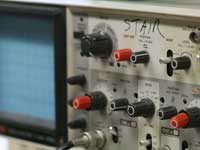Ultra-high vacuum study of atomic layer deposition (ALD)
The goal of this work is to use an ultra high vacuum (UHV) instrument to develop a better understanding of the molecular processes that take place during atomic layer deposition (ALD) and use that knowledge to develop novel catalytic systems. Advancements in ALD enable the formation of high surface area oxide supports along with metallic nanoparticles. While a basic understanding of this process exists, there are many fundamental questions about the mechanism and the fate of the individual components that are still left unanswered.
We are hoping to mimic the ALD process that is typically done at low vacuum, in an UHV environment. This type of a low pressure environment is crucial for the exploration of surface reactions without the impediment of atmospheric gases, which tend to overwhelm and deflect the molecules of interest. The current chamber is outfitted with several surface science tools (XPS, mass spectrometer, Auger, LEED, HREELS). Other unique features of this instrument are the high pressure cell located at the bottom of the chamber and the dosing lines on the side. ALD can be performed through either the dosing lines or the high pressure cell. Allowing us the ability to synthesize and analyze a catalytic system at different stages of formation without removal of the sample from the chamber.
 Figure 1.
Figure 1.
Ultra high vacuum chamber (left). Photo of the inside of the chamber including the sample holder and photos of the high pressure cell (right).
X-ray photoelectron spectroscopy is a powerful tool for this project because it provides information about the identity, electronic state and the concentration of surface species. Comparisons between spectra taken before and after dosing surfaces can provide an insight into the mechanisms of the surface reactions as well as the fate of the surface species. These experiments will help identify properties of the support and nanoparticles that influence the catalytic ability of the system.
Grant: NSF

